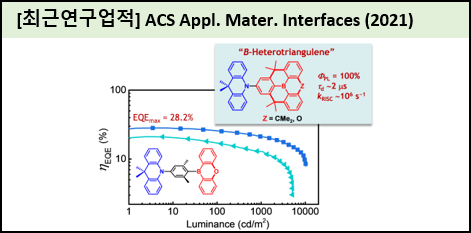|
Title |
Blue TADF Emitters Based on B-Heterotriangulene Acceptors for Highly Efficient OLEDs with Reduced Efficiency Roll-Off |
|
Author list |
Lee, Young Hoon; Lee, Woochan; Lee, Taehwan; Lee, Donggyun; Jung, Jaehoon Jung; Yoo, Seunghyup; Lee, Min Hyung |
|
Publication date |
2021/09 |
|
Citation information |
ACS Applied Materials & Interfaces, 13, 45778 (2021)
|
|
DOI |
10.1021/acsami.1c10653 |
|
Graphical Abstract |

|
|
Abstract |
The design of robust boron acceptors plays a key role in the development of boron-based thermally activated delayed fluorescence (TADF) emitters for the realization of efficient and stable blue organic light-emitting diodes (OLEDs). Herein, we report a set of donor (D)acceptor (A)-type blue TADF compounds (13) comprising triply-bridged triarylboryl acceptors, the so called B-heterotriangulenes, which differ depending on the identity of one of the bridging groups: methylene (1), dimethylmethylene (2), or oxo (3). The X-ray crystal structures of 2 and 3 reveal a highly twisted DA connectivity and a completely planar geometry for the B-heterotriangulene rings. All compounds exhibit blue emissions with the unitary photoluminescence quantum yields and small singlettriplet energy splitting (< 0.1 eV) in their doped host films. The compounds exhibit a fast reverse intersystem crossing rate (kRISC 106 s?1) with short-lived delayed fluorescence (?d 2 s), which is found to be promoted by the strong spin-orbit coupling between the local triplet excited state (3LE, T2) and singlet (S1) states. Using compounds 13 as the emitters, highly efficient blue TADF-OLEDs are realized. The devices based on the emitters with B-heterotriangulenes exhibit better performances than the device incorporating a singly-bridged reference emitter over the whole luminance range. Notably, the device based on the fully dimethylmethylene-bridged emitter (2) achieves the highest maximum external quantum efficiency (EQE) of 28.2% and the lowest efficiency roll-off, maintaining a high EQE value of 21.2% at 1,000 cd/m2. | |

